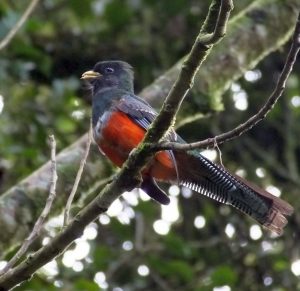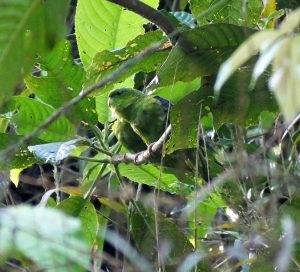Last weekend, I made my almost annual trip to Tapanti National Park. Like most places in Costa Rica, it’s not that far away, but like most places in Costa Rica, it’s also not the easiest of drives to make as a day visit. It is if you live around Cartago but if you happen to reside over near San Jose, there’s just no way to avoid the traffic, especially on the slow drive back. That’s the only thing that keeps me from visiting more often and I always wish I could because it’s one of the easiest places in the country for accessing high quality middle elevation forest.
The road through Tapanti.
We see similar forest types on the drive through Braulio Carrillo National Park but the lack of trails and places to stop means that “thou can look, but ye cannot touch” those areas where Rufous-breasted Antthrushes call, and Ochre-breasted Antpittas hide. Since there’s some other species at that elevation that I would love to get for the year, rarely see or hear, and for which we also need images for the birding field guide apps I work on, I’m always wanting to walk in those mossy middle elevation forests.
Tapanti provides a chance at those species and more, and although birds like Rufous-rumped Antwren and Red-fronted Parrotlet are still rare, this national park is one of the better places to look for them. Since there was also a recent bamboo seeding event in the park, Susan and I decided to risk the traffic and do a day trip to Tapanti. On the way there, we made the usual brief stop in front of Lankester Gardens to see if we could come across Sedge Wren and White-throated Flycatcher. No luck on Sunday although we only made a brief check for them on the edge of the remnant, endangered sedge field. Here’s an eBird list from the brief stop: http://ebird.org/ebird/view/checklist/S31425150
Next, we cruised over to Tapanti, stopping just before the entrance to the park (since it doesn’t open until 8). Luckily, you can still see quite a few cool birds in that first area of forest, including the Streaked Xenops that we got. No luck with the monklet or antpittas but it’s always worth it to try for them.
We also had Collared Trogon.
Once the park opened, we waltzed on in and began with the birding. Our first species in the park were Ruddy Pigeons calling behind the HQ, expected Golden-bellied Flycatcher, and looks at Red-headed Barbet. Shortly after, we came across the first area of seeding bamboo and stopped to investigate. Seeds were still present but sadly, there wasn’t any sign of Slate-colored Seedeater, Blue Seedeater, nor Slaty Finch. However, intriguing glimpses of something moving in the bamboo resulted in scope views of Barred Parakeets!
This was the first time I have seen this species perched.
Although it’s easy to see this small parakeet calling and flying high overhead at various sites, it’s a real treat to see them perched. As we watched them, I understood why I have seen hundreds (probably thousands) of Barred Parakeets in Costa Rica, Mexico, and Ecuador without ever see the small green parakeet off the wing. This perched pair of very unobtrusive parakeets reminded me of owls the way they blended in with their surroundings. If we hadn’t seen them move, we would have just walked on past, oblivious to their presence. It was even hard to find them after knowing where they were.
There are Barred Parakeets somewhere in this image.
We enjoyed those Barred Parakeets for a while, hoping for other bamboo birds to show. They never did but it was still a treat to see the parakeets allopreen, and see one of them making what appeared to be soft calls that we couldn’t hear.
Further up the road, we ventured onto the steep Arboles Caidos trail but with the sunny weather and walking on it during the most non-birdy time of the day, we saw very little. There were some Spotted Barbtails, Lineated Foliage-gleaner, and some other expected species but we dipped on antpittas, the outside chance at the Central American form of the Black-banded Woodcreeper, and didn’t even hear Rufous-breasted Antthrush. It was still nice to get some exercise in beautiful forest though.
We also had several Wedge-billed Woodcreepers.
After exiting the trail at 11, a lot of Sunday visitors had arrived in the park, and some rain started to fall. We cruised the main road looking for mixed flocks and had a bit of luck but not with THE mixed flock I was hoping for (that would be the one with the rare birds). When the rain picked up and turned into a constant downpour, we decided to call it a day and make the drive back. The drive wasn’t all that bad although the pouring rain pounding the roadway wasn’t so fun.
If you plan on visiting Tapanti, try and speak with the rangers the day before to ask about an early entrance. If you can do that, head right over to the Oropendola trail and scan for Scaled Antpitta. It’s also better during mid-week. Bring your own food or have lunch at the small soda just outside the park- take the first right just after the forest and drive up to the small diner.
Happy birding!























